The Comic News, Lincoln, and the Civil War
Skip other details (including permanent urls, DOI, citation information): This work is licensed under a Creative Commons Attribution-NonCommercial-NoDerivatives 3.0 License. Please contact [email protected] to use this work in a way not covered by the license.
For more information, read Michigan Publishing's access and usage policy.
Neatly tucked away in the archives of history and hidden from the view of scholars for more than a century are political caricatures, satire, and doggerel of Abraham Lincoln and the Civil War found in the Comic News, one of London's humorous illustrated weeklies, and its short-lived successor The Bubble. [1] When the Comic News threw its hat into the journalistic ring, English caricature and satire of Lincoln and the Civil War were dominated by the venerable Punch and the newcomer Fun. In fact, the lengthy shadow cast by Punch and Fun ultimately doomed the Comic News to its early demise in March 1865, approximately nineteen months after its birth on July 18, 1863. Despite the economic realities that destined the rare periodical to obscurity, its robust humor and political posture with respect to Lincoln and the Civil War deserve a better fate in the annals of history.
If for no other reason, this rare comic periodical is valuable for the Lincoln caricatures created by the illustrator Matt Morgan during the last six months of publication. Morgan is well known for his Lincoln cartoons in Fun. The Lincoln images in the Comic News solve the mystery of why Morgan's seminal Civil War illustrations ceased appearing in Fun in October 1864. That same month, Morgan accepted an assignment as the leading illustrator for the Comic News. Thus, the Comic News illustrations perpetuate an unbroken chain of Civil War art from his years with Fun to the beginning of April 1865. Moreover, while the Comic News added ten significant "new" Morgan cartoons, it also sponsored Civil War illustration from a few other British illustrators. Hence, Lincoln and Civil War scholarship, as well as art and journalism history, are richer Page [End Page 53] and more complete as a result of the Comic News. However, the Comic News has much more to offer than Morgan's fine popular art.
The inaugural issue of the Comic News was launched under the editorship of Henry Byron. Initially, C. H. Bennett, W. M'Connell, and W. Brunton were its illustrators. At first, Civil War content was sparse. In fact, for the first month, the conflict was completely ignored. In due time, however, the fledgling periodical rivaled Fun, if not Punch, for its attention to the American conflict. [2] During that first year, Lincoln and Civil War caricatures were rare for the Comic News, but significant volleys from the comic editorial and satirical doggerel genres commenced in August 1863.
American Want of Intelligence
On August 22, a series of comic editorials under the intriguing and telling title "American Want of Intelligence" was originated by the Comic News's New York-based war correspondent, with the byline "From Our Own Manhattan." From the standpoint of Union sensibilities, consistent with its humorous sisters Punch and Fun, the fairly regular editorial piece was irreverent, satirical, condescending, nationalistic, critical of American leadership, sympathetic to slavery, and, by default, slightly more partisan to the Confederate cause. By far, Lincoln was the most frequent target of scorn: "From first to last," noted the initial editorial, "I have maintained the utter incompetence of Abe Lincoln." [3] One week later, the writer predicted, "As long as Lincoln is suffered to remain at the head of affairs, there is no real hope for America."[4] Although "Our Own Manhattan" decried, quite justifiably, the quality of Union generals, including McDowell, Little Mac, Pope, Burnside, and Hooker, he reserved his most potent contempt for the commander-in-chief. [5]
Civil War Caricature and Doggerel to July 1864
Although Lincoln's image in the British comic press was typically pejorative, there were moments of ambivalence. When Ulysses S. Grant's siege at Vicksburg finally yielded victory and the battle at Gettysburg denied Robert E. Lee's dream for a crushing conquest in the North, Union optimism filtered through the doggerel of the Comic News.[11] The title of the piece, "General Bragg's Last Despatch to President Lincoln," refers to a fictitious Union general, "Titus Bragg," who boasts of imminent victory. Three concluding verses sample the substance and flair of the doggerel.
Although the first Comic News political caricature of Lincoln and the Civil War was actually designed to criticize England's foreign secretary, Lord John Russell, the net effect of the cartoon was to portray Lincoln as a strong leader.[12] This illustration came after another diplomatic confrontation between the United States and Great Britain. When the United States lodged vigorous protests against Great Britain for winking at Confederate contracts for warships with the Laird shipyards in Liverpool, diplomatic relations between the two countries were sorely strained. [13] And when the Confederate ship Alabama, a product of the Laird Brothers' commercial enterprise, began wreaking havoc with the Union naval forces, the cry of foul play reached a new fever pitch. On the other hand, supremacy of the seas in technology or any other category was a matter of pride for British public opinion. The average English citizen did not seem to mind what Lincoln perceived as an unholy alliance between the nation's shipbuilding industry and the Confederacy. In fact, nationalistic fervor resented the perceived retreat by the British government to placate the umbrage taken by the Lincoln administration.
William M'Connell, an adroit political caricaturist, capitalized on this international clash of political will.[14] He used the naturally diminutive Lord Russell in contrast with the lanky Abraham Lincoln Page [End Page 57] to underscore the notion that Russell was permitting Lincoln to bully John Bull. Satirizing "British Pluck," M'Connell subtly portrays Lincoln and Russell as "Licensed Drovers," literally people who drive domestic livestock such as sheep, but in this figurative case, drivers of "Rams"—ships that were characterized by a ramming device. A subdued and deferential Russell is shown kowtowing to Lincoln under a sign pointing to "Laird Yards." The caption strengthens the forceful, threatening image of Britain losing face on the diplomatic front: "Lincoln—'Now, drover-boy Jack, if you let out them Rams, I won't answer for the consequences.' Russell (very humbly)—'No, Sir—please, Sir—I'll do whatever you tells me, Sir—in course, Sir—yes, Sir—please, Sir.'"[15]
That the British followed the fortunes of these ships with interest is especially clear in the case of the Alabama. Constructed at the Laird shipyards, the Alabama left Liverpool in late July 1862 for the Azores, where it was equipped with armament for service as a Confederate warship. Among its most conspicuous conquests was the sinking of the USS Hatteras in January of 1863. In the Comic News lyrics celebrating the Alabama's victories were adapted to a popular air, "The Saucy Arethusa." The last three verses of The Alabama convey the tone of national pride. [16]
The Alabama

When the USS Kearsage did finally catch up with and sink the CSS Alabama, a journalist for the Comic News wrote three more verses to be sung to the same air. Because of the superior fire power of the USS Kearsage, the final verse doggedly claims a moral victory.[17]
Although readers of the Comic News were preoccupied for a time with the Alabama, Lincoln remained the favorite bull's-eye for derisive humor. Just about any pretext was used to discredit Lincoln while entertaining readers of the Comic News. "The ladies, it seems, have wheedled old Abe out of the original draft of the Emancipation Proclamation. They have also persuaded him to give them the shirt that he wore on his way to Washington, when he was nearly murdered in Baltimore." [18]
Although it had been nearly three years since those charged with Lincoln's safety advised him to slip unobtrusively through Baltimore on his way to his inauguration, that event had neither lost its comic power nor the bite of ridicule. Because England continued to see American manners as unworthy of British societal standards and the rural Lincoln woodcutter as the perfect foil to validate their impressions of this hopeless international gulf in social graces, "The Tale of the President's Shirt" was a natural conclusion to the popular premises of disdain. Furthermore, it was one more arrow in the quiver of the comic genre to send flying at its tall target.
The Tale of the President's Shirt
Other comic pieces chided Lincoln for the use of paper money, the alleged economic shambles of the Union, [20] the abuse of "Shoddy-Contractors," [21] his supposed unwillingness to entertain diverse opinion, the unsubstantial paper victories, and "the Bunkum he talks about" African Americans.[22]
The African American Image
Typical of the media in general and comic journalism in particular, both at home and abroad, the Comic News reflected and shaped the views about people of color. The Civil War made that issue more salient on both continents. Overwhelmingly, the image was pejorative. Nevertheless, on September 5, 1863, a lengthy piece of doggerel argued that the welfare of African Americans was equally miserable north or south of the Mason-Dixon line. "Whether Hooker win or Lee" predicted the realist poet, the future for slaves was not bright. Included here are six verses of doggerel popularizing that view: [23] Page [End Page 62]
But these "White broders t'oder side Atlantic" were not paragons of tolerance or charity either. The Comic News justified slavery on the grounds of racial inferiority, rationalized the use of the "lash," maligned the abolitionist movement, [24] and chided Lincoln for his moderate racial views. [25] Illustrations only complemented this negative theme. For example, the famous British illustrator George Cruikshank assembled an Englishman, an African American, and a domesticated gorilla to mock the caption "Are We Not All Brothers?" [26] Page [End Page 63] Later, Yorick, a cartoonist, catered to the fears of ethnic domination.[27] He depicted "The Last (White) Man; Or, A Possibility For America in 1874" being auctioned by Senator Jumbo (an African American) as "The only live specimen now existing of the one and indivisible great Republic of the United States."[28]
The War in America
Between July and mid-September 1864, a series of comic satires entitled "The War in America" monopolized the Civil War content of the Comic News. One had to read between the lines to get any information about the war because, like the earlier series "American Want of Intelligence," this display of raillery was like something the American humorist Artemus Ward might have written. The breezy articles thrived on farce, word play, satire, puns, and the absurd. Lincoln, a "tall, gaunt, lean, morose looking figure, with long slender arms, and legs all over the place," continued to attract jocular, demeaning commentary. One version featured a tobacco-chewing president. "Ah, sir, chewing's one of the great insti-chew-tions of our country, some of our greatest men has chewed in their time. But the old dominion's almost chawed up! The President here emitted from his mouth an expectoration of the most alarming magni-chew'd, and shot it with a true and steady aim right on the left boot of your amiable and boot-iful correspondent." [29] Later, "our special correspondent in the Federal States" concluded, "So poor America is ruled, and scolded, and schooled, by a buffoon, a monkey, a wretched old donkey, who is more fit for a flunkey than to rule this great country. Old Abe's a muff—or, to pile it strong, 'muffer;' his wisdom's all stuff, and he's a regular duffer."[30]
In the aftermath of Gettysburg, the Comic News's special correspondent derided Lincoln's ability as a speaker. "The language of Abraham Lincoln, President of the Minor portion of the Dis- Page [End Page 64] United States of America, is commonly of so vulgar a nature as to be, in the language of the Comic News Police Reporter, 'totally unfit for publication.' Mr. Lincoln has made himself almost hymn-mortal by his disgusting song-singing on the flat of Gettysburg, and for further immorality he must get his character improved, or he will never be recognized as a genius by the genial correspondent of the Comic News." [31]
For this same period, there were other prey for sneering, too, including Gen. Ben Butler. [32] Still, "Beast Butler" was no match for the amount of attention accorded Lincoln.[33] For example, in the summer of 1864, when Lincoln's prospects for reelection were bleak, the Comic News predicted, that following the election, Lincoln would be splitting rails again. [34] A cartoon captioned "The Great Donkey Show," the animal rogue's gallery of national leaders, included the "Prussian Mule No. 1," the "German Donkey," and the North's and South's fighting "American Wild Asses."[35] Although Prussia and Germany were not commended by their inclusion in this group, the linguistic regression from "mule" and "donkey" to "wild asses" conclusively designated the Americans as the sole occupants of the bottom rung of the international political ladder. To Napoleon's suggestion that "those American animals ought to be separated" Mrs. Britannia replies, "I've spoken to my foreman about it. I'm sorry to say he is not as active as he used to be." The dialogue demonstrates the role that British public opinion played in keeping pressure on their own leadership to upbraid their cousins' behavior abroad. To be sure, these two "American Wild Asses," might have also easily conjured up the images of the two most salient protagonists, Jefferson Davis and Abraham Lincoln.
The Comic News Acquires Matt Morgan
One of the most significant discoveries from the pages of the Comic News is nearly a dozen political caricatures of Abraham Lincoln, primarily from the pen of Matt Morgan. Although Morgan, a Page [End Page 65]
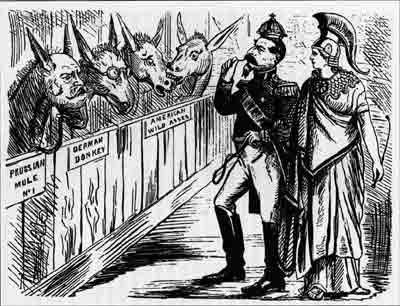
By the fall of 1864 the survival of the Comic News, like the flagging fortunes of the Confederacy, was also questionable. The humor periodical had been steadily losing ground in its head-to-head competition with Punch and Fun. Extraordinary measures would now have to be taken to resuscitate the dying publication. In the September 17, 1864, issue of the Comic News, an announcement alluded to these strong measures: "The next number of the Comic News will be conducted under entirely new management." Also Page [End Page 67] noted was the intention of the management to begin offering a "cartoon of great political importance." To accomplish that purpose and bolster sagging sales, Matt Morgan, the leading Civil War cartoonist for Fun, was hired.
For nearly three years Morgan had drawn piercing caricatures of Lincoln and some of the central themes of the Civil War. At least ideologically, this was not a difficult transition for Morgan because the two publications shared a common philosophy. Fun reveled, too, in criticism of the conduct of the American conflict, specifically in Lincoln's leadership. In fact, Morgan took up his pen with the Comic News just where he left off with Fun. On September 17, 1864, Morgan's last Lincoln caricature with Fun depicted the president as "Columbia's Nightmare."[38] Similarly, his first assault on Lincoln in the Comic News portrayed Lincoln as the devil.[39] In the vintage Morgan cartoon "Pull Devil—Pull Baker" Lincoln and McClellan, contestants for the presidency of the United States in the 1864 election, are shown tugging for control of a map of the "Northern States." A torn map of the "Southern States" is already on the ground. Morgan's rendering of Lincoln as Satan casts the cartoon more in the anti-Lincoln camp than in the pro-McClellan category. [40] But Morgan's felicitous debut in the Comic News was not the only significant content of the period.
In the early fall of 1864, written satire and humor were not entirely forgotten. For example, the Comic News offered the latest betting odds for the "Richmond Cup" (occupation of the Confederate capitol). They wagered "10 to 1 on General Lee's superior science; 50 to 1 against General Grant's inability; ... 40 to 1 on General Sheridan's advance; ... and 50 to 1 against Abe Lincoln's lot." [41] Page [End Page 68]

Any political tension between the Lincoln administration and Great Britain created public apprehension in England over the welfare and security of Canada. [43] That anxiety and sense of vulnerability was reflected in the next Morgan cartoon, "Advice Gratis." [44] The male figure symbolizing Canada sits on a large branch of a huge tree labeled "Old England." Standing below, "Abe" calls out to "Canada," "Now, sir-ree cut that connexion. I'll loan you a saw!" Canada retorts, "You're barking up the wrong tree, old friend: I'm only binding up the outlying branches." Canada's precarious position on the branch underscores the destructive consequences that any Canadian break with England would have caused. From England's standpoint, severing the emblematic branch of Canada from the British trunk would have been tantamount to Canada's downfall. The cartoon also conveys the notion that Canada was seeking to strengthen, not weaken, its affiliation with England.
In November, Morgan wistfully ventured a cartoon prediction of the winner of the 1864 presidential election. He missed the mark. [45] Although the winner of the election had not been a foregone conclusion early in the campaign, Lincoln gained popularity as decisive Union victories multiplied. In "Exit Abe," Lincoln is shown falling through a trap door as a result of the verdict of the popular ballot. Columbia appears to be relieved as she casts the deciding vote that sends a disgruntled Abe to political oblivion. Page [End Page 70]
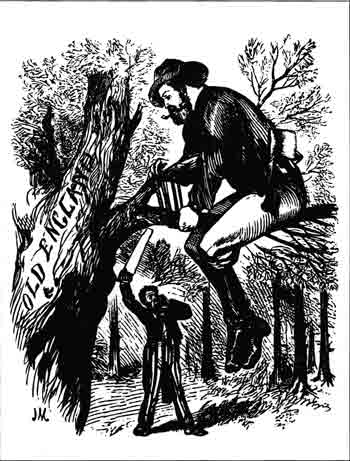

But Lincoln's victory did not soften Morgan's cartoon rhetoric toward the president. Rather, it seemed to intensify antipathy, and the tone became more vindictive. For example, Morgan gave a spirited rendition of Lincoln as "The Vampire."[47] This time the president's supposed victim was a helpless Columbia. A menacing Abe threatens, "Columbia, thou art mine; with thy blood I will renew my lease of life—ah! ah!" In effect, Morgan's caption asserted that Lincoln was opportunistically and unscrupulously perpetuating his political power through the immoral tool of Civil War.
No British cartoonist was as consistently hostile to Lincoln as Matt Morgan. Neither Punch nor Fun followed this more critical postelection pattern. As a matter of fact, Fun virtually dropped Lincoln caricature when Morgan left and replaced it with a more general, graphic Civil War commentary. And whereas the earlier Morgan exploited the rural simpleton, awkward oaf, incompetent buffoon, and inept president imagery, the later version imputed more malevolent motives. Themes of blood, death, tyranny, intimations of war crimes, and even the propriety of hanging Lincoln exemplify the more hostile content.
Part of this change in image may be due to the bloody character of the later stages of the Civil War. No one could deny the formidable and morbid statistics of casualties and loss of life. Moreover, Lincoln was not the only focus of such criticism. In a brief article titled "American Intelligence" the Comic News was uncharacteristically sober as it chided General Grant for his role in the shedding of blood: "The initials of General Grant happen to be U.S. The New York Herald and other journals have interpreted these mysterious letters as meaning 'United States Grant,' 'Uncle Sam Grant,' and lastly, in allusion to the fall of Vicksburg, 'Unconditional Surrender Grant.' The names, in their way, are not bad; but Mr. James Gordon Bennett seems to have forgotten another translation of his pet initials, 'Unlimited Slaughter Grant.'"[48] Nonetheless, the gruesome reality of war does not explain away Morgan's singular, aggressive style. Page [End Page 73]
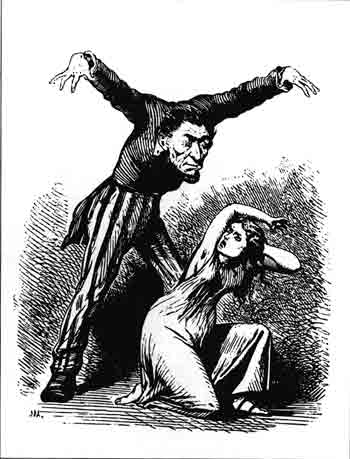
None of this is to say that Lincoln's homespun image disappeared. In fact, the Comic News effectively blended the morbid and rural images with the clever use of lower-class dialect in doggerel entitled "The Northern Harmer; or the Abraham Lincolnshire Farmer."[49]
Morgan acknowledged the reelection of Lincoln to a second term in a cartoon vilifying the president as the personification of death.[50] At first glance, Lincoln appears to be a cricket player in the cartoon titled "In for His Second Innings." However, when the president's mask is removed, his true character as the agent of death is exposed. In the background, the dead body of a soldier and crippled war machinery emphasize the point. Morgan tarnishes Lincoln with the dual images of duplicity and insensitivity to the brutal consequences of war. In any case, Morgan persistently denounces Lincoln and casts him in the role of villain. Page [End Page 75]

In the same issue, humorous satire imagined what Longfellow, Whitman, and Emerson thought of Lincoln and the war. A fictitious Fanny Fern represented the women's view. [51] The satirist imitated and mocked Longfellow's poetic style, ascribing these verses to him:
In the context of the Civil War, the energetic British foreign secretary John Russell was a popular subject for caricature. At the end of 1864, Morgan drew Russell, in conjunction with France's Napoleon and America's Lincoln, as "Our Mutual Friend." However, the implication of friendship was pure sarcasm. Morgan's intent was to question the foreign policy effectiveness of Russell. Lincoln tries to manipulate and coerce Russell; Napoleon condescendingly waits his turn in the background. [52] Once again, Morgan uses the physical size discrepancy of a short Russell and taller Lincoln and Napoleon figures to amplify the notion of influence. The final print of 1864 shows the Union burning while Lincoln, "The Yankee Page [End Page 77] Nero," giddily plays wooden percussion instruments between his fingers. [53] Like Nero, Lincoln looks upon the burgeoning holocaust with absolute indifference and wears a Roman crown to round out the analogy. This image of Lincoln as a ruthless emperor, king, or dictator who tyrannicaly usurped power and dominion was more typical of the extreme Confederate view. [54] A milder version, containing elements of this image of the misuse of power, also surfaced among Lincoln's opponents in the Democratic Party.[55] Morgan's linkage of Nero to Lincoln was by no means unique.
Since coming on board as an illustrator for the Comic News, Matt Morgan had indeed enlivened the periodical. Quantitatively, in just three months his seven full-page Lincoln caricatures eclipsed any comparable offering in Fun or Punch. Qualitatively, although pitted against the high standard of John Tenniel's work in Punch, Morgan held his own. Like Tenniel, Morgan focused almost exclusively on the anti-Lincoln theme. On the other hand, the artists for Fun, perhaps not eager to compete with either Tenniel or Morgan on their specialty—the Lincoln image—wisely opted for more generic Civil War motifs. Unfortunately, Morgan's impressive burst of creative energy was no cure for the ailing condition of the Comic News. Within three months it would be history and its successor, The Bubble, a two-week flash in the pan.
The Passing of the Comic News
In January 1865, Morgan's artistry temporarily disappeared from the pages of the Comic News. In fact, during that first month of the new year, only a single entry of doggerel represented the entire spectrum of Civil War content. That piece chronicled the saga of the CSS Florida. The Florida was built in Britain, armed with weaponry in Nassau, and made battle ready by the fall of 1862. Two years later, after a distinguished record at war, the Florida anchored temporarily off the coast of Brazil. Lured into a false sense of security by the rules of international warfare, the crew of the Florida wrongly assumed that the USS Wachusett would abide by the code of international law. Instead, the Wachusett captured the Florida, towed it to Chesapeake Page [End Page 78]
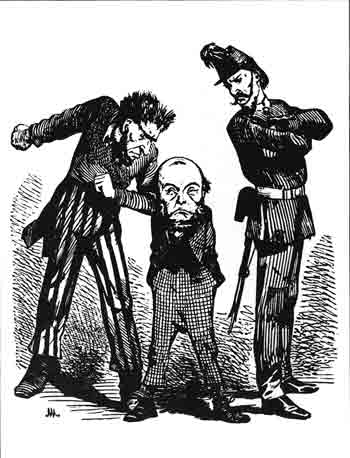
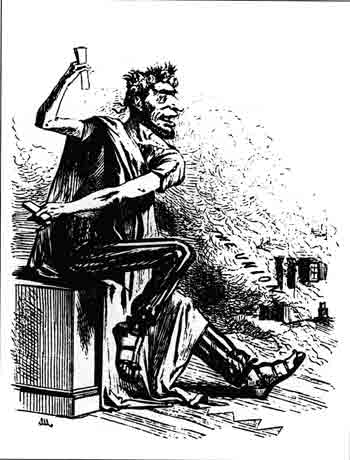
Bay, and unceremoniously sunk its troublesome foe. [56] "The Wreck of the Florida" was a parody of Longfellow's "Wreck of the Hesperus." Authorship of the humorous poetry was attributed to "Ab——m L—nc—n, or some other Tall Fellow." [57]
Moral.
In February, Morgan's first caricature of 1865 was faithful to the usual pattern—another jab at Lincoln.[58] For this cartoon, the level of enmity rose a notch. "A Valentine for Abe" was sent to the White House "from a few admiring friends." The print shows Lincoln looking at the valentine. He is shocked and dismayed as he views a drawing of his own body, his hands tied behind his back, swinging from the gallows. Although rare in England, this kind of Civil War gallows humor was not uncommon in the United States, nor was the theme confined to Abraham Lincoln.[59] Jefferson Davis received comparable treatment from artists in America. [60]
The fear that Lincoln might do something rash with respect to Canada endured in British public opinion until the end of the war. Morgan helped to sustain those apprehensions. He portrayed Lincoln as "The Yankee Eagle," descending on a complacent, sleeping English lion. Lincoln's head is affixed to the eagle. Just before his landing, the eagle warns: "Wake up, old hoss! I'm guin to swoop down on yer biggest jewel." [61] In reality, at this stage of the war Canada was not even a remote consideration in Lincoln's foreign policy. Nevertheless, international tension and war bred a spirit of suspicion and paranoia.
By March, the demise of the Comic News was imminent. Just as irrational measures are sometimes taken by loving associates to prolong the inevitability of a relative's death, in desperation the management of the Comic News renamed it The Bubble, but that Page [End Page 82]
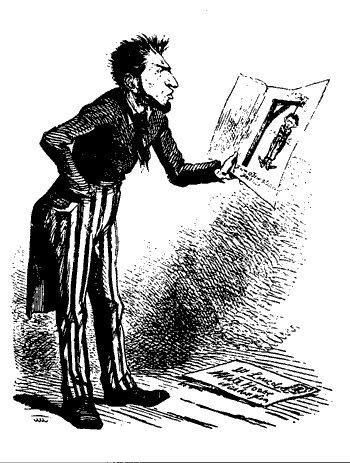
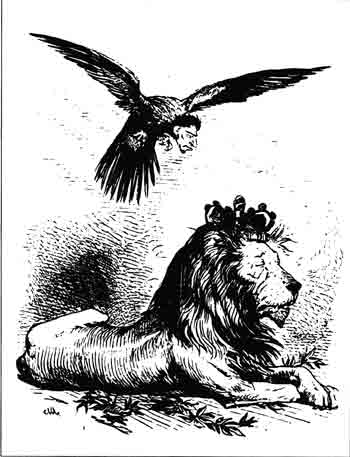
As the publication figuratively gasped for breath, Matt Morgan came back for one final encore, a memorable finale for the last issue of The Bubble. [62] A despairing, disheviled Lincoln glances at Columbia, laden with "debt" and "misery." With a broken noose hanging from his neck, a ball and chain around his leg, and a cemetery with crosses and tombstones in the background, Lincoln is condemned by the reproachful Columbia. The verdict seals his destiny to a life of rail-splitting. Indeed, at Lincoln's feet is a bundle of rails and an axe. Thus Morgan's fantasy of poetic justice defined "Abe's Future" as a return to where the cartoonist thought Lincoln belonged—back at his humble beginnings.
Given the imminent defeat of the Confederate forces and the euphoria associated with the triumphal consummation of Lincoln's dreams of Union, Morgan's drawing was ironic. As the final sun set on the destiny of the Comic News and The Bubble, it rose in splendor, marking the dawn of a new era for America. For the wrong reason, Morgan was right about the bleak nature of Lincoln's immediate future. But he was dead wrong about his place in history.
Conclusion
One wonders whether Morgan would have liked to have one more opportunity, like Punch's John Tenniel [63] or the artistic staff of Fun, [64] to make peace with the memory of Abraham Lincoln. Given his intransigent opposition to Lincoln, the form a conciliatory Matt Morgan cartoon might have taken tantalizes the imagination. However, in his own way, Morgan was belatedly reconciled to the memory of Abraham Lincoln.
With the publication of his volume The American War, dominated as it was by his own cartoons, Morgan made a final statement about his lasting image of Lincoln. [65] The images he selected and omitted for that work from his repertoire as well as the few images he borrowed from others is vital to measure Morgan's Page [End Page 85]

None of the caricatures in either the Comic News or The Bubble were published in Morgan's volume. Why? Only one answer seems plausible. Given the uncharitable tone of virtually all of those cartoons, he must have deliberately chosen to exclude them. That alternative choice obviously had implications for Morgan's evaluation of Lincoln. He may have considered those final caricatures too harsh for the verdict of time. If so, Morgan's "final" appraisal of the deceased president was consistent with the steady, positive transformation of the Lincoln image.
For a year and a half, the Comic News entertained its loyal patrons. Those subscribers and pay-as-you-go benefactors were treated to a comic perspective from England of the Civil War and Abraham Lincoln much like its more famous peers Punch and Fun. To be sure, the Comic News liberally borrowed from the tradition established by Punch and mimicked by Fun. Although true to the pattern, the Comic News made a significant contribution to the comic tradition and placed an indelible mark on the archival legacy of Lincoln and Civil War image history in satire, doggerel, and popular art. Page [End Page 87]
Notes
-
Because The Bubble was only a brief
successor, lasting just two weeks, the major focus of this
discussion is upon the Comic News. Although the data from
The Bubble are combined with the Comic News, specific
citations from The Bubble are acknowledged in the notes.

-
Between July 18, 1863, and March 28, 1865, the
collective duration of the Comic News and The Bubble,
a comparative content analysis of Civil War prose, illustrations,
and poetry in Punch, Fun, and the Comic News (because
The Bubble was only a brief successor, the statistics from
the two periodicals are combined under the Comic News)
reveals that Punch published 50 percent, Fun 27
percent, and the Comic News 23 percent of the total
material. The only category in which Punch did not lead was
in the percentage of cartoons. Fun published 41 percent,
Punch 35 percent, and the Comic News 24 percent of
the popular art.

-
Comic News, August 22, 1863, 44.

-
Comic News, August 29, 1863, 52.

-
Comic News, September 12, 1863, 66.

-
Comic News, September 19, 1863, 79.
These dire statements of economic distress were not sustained by
the facts. On October 3, 1863, Lincoln proclaimed a national day of
Thanksgiving, in part because of the economic blessings enjoyed by
the North. "Needful diversions of wealth and of strength from the
fields of peaceful industry to the national defence, have not
arrested the plough, the shuttle or the ship; the axe has enlarged
the borders of our settlements, and the mines, as well of iron and
coal as of the precious metals, have yielded even more abundantly
than heretofore. Population has steadily increased, notwithstanding
the waste that has been made in the camp, the siege and the
battle-field; and the country, rejoicing in the consiousness of
augmented strength and vigor, is permitted to expect continuance of
years with large increase of freedom." The Collected Works of
Abraham Lincoln, ed. Roy P. Basler, Marion Deloris Pratt and
Lloyd A. Dunlap, asst. eds., 9 vols. (New Brunswick: Rutgers
University Press, 1953–55), 6:496 (hereafter cited as
Collected Works).

-
Comic News, October 3, 1863, 91.

-
Comic News, October 10, 1863, 101.

-
Comic News, October 31, 1863, 125.

-
Comic News, November 21, 1863, 151.

-
Comic News, August 22, 1863, 46.

-
Comic News, November 14, 1863, front
page.

-
See Howard Jones, Union in Peril
(Chapel Hill: University of North Carolina Press, 1992),
146–47.

-
Because art historians are unaware of the
existence of the Comic News, William M'Connell is credited
for only appointments as cartoonist to Punch and The
Illustrated Times. "His style is always exaggerated and
grotesque with slight similarities to 'Phiz' or John Leech but
never so well drawn." Simon Houfe, The Dictionary of British
Book Illustrators and Caricaturists, 1800–1914
(Woodbridge, U.K.: Antique Collectors' Club, 1978), 378.

-
"Eventually the Palmerston ministry clamped
down on such shipbuilding activities but not before both physical
and diplomatic damage had occurred." Jones, Union in Peril,
147.

-
Comic News, March 5, 1864, 117.

-
Comic News, July 2, 1864, 315.

-
Comic News, December 19, 1863, 182.

-
Following Lincoln's assassination, the issue of Lincoln's so-called manners took on new meaning. "Ralph Waldo Emerson saluted Lincoln as an 'aborignal man' unspoiled by European culture and tradition. The manners of the living Lincoln had troubled Emerson; with many others, however, he had struggled to overcome that prejudice, and he now embraced him as the inspired leader of the nation. 'Rarely was man so fitted to the event.'" Merrill D. Peterson, Lincoln in American Memory (New York: Oxford University Press, 1994), 15.

-
"Not only did the war not greatly impede
growth, but it did not even distort the economy unduly." Mark E.
Neely, Jr., The Last Best Hope of Earth (Cambridge: Harvard
University Press, 1993), 141–42.

-
See Gary L. Bunker and John Appel, "Shoddy,
Anti-Semitism, and the Civil War: The Visual Image," American
Jewish History 82, nos. 1–4 (1994): 43–71.

-
Comic News, January 2, 1864, 4. At
this time, Lincoln's actual rhetoric on African Americans included
"How to better the condition of the colored race has long been a
study which has attracted my serious and careful attention; hence I
think I am clear and decided as to what course I shall pursue in
the premises, regarding it a religious duty, as the nation's
guardian of these people, who have so heroically vindicated their
manhood on the battle-field, where, in assisting to save the life
of the Republic, they have demonstrated in blood their right to the
ballot, which is but the humane protection of the flag they have so
fearlessly defended." Collected Works 7:101.

-
Comic News, September 5, 1863, 58. The
condescending ethnic tone was typical of the period.

-
Comic News, August 29, 1863, 52.

-
"Alphabet for Young America," Comic
News, January 2, 1864, 4.

-
"Are We Not All Brothers?" Comic
News, December 5, 1863, 165.

-
The only listing for a Yorick is spelled
Yorrick. No first name is given. Simon Houfe asserts that
"Yorrick" is a "pseudonym [for an] illustrator of children's books"
but does not identify the referent for the pseudonym. Houfe,
Dictionary of British Book Illustrators and Caricaturists,
1800–1914, 506.

-
"The Last (White) Man: Or, a Possibility for
America in 1874," Comic News, April 16, 1864, 187. In
America, fears of ethnic domination were not confined to African
Americans. Comic periodicals whipped up prejudice in cartoons
against Jewish, Chinese, and Irish Americans on similar grounds.

-
"The War in America," Comic News,
July 23, 1864, 29.

-
Comic News, August 27, 1864, 93.

-
Comic News, September 3, 1864, 101.

-
"A General Wish against General Butler,
Who's General-Lee Hated," Comic News, August 20, 1864, 77.

-
For Lincoln's general treatment in the
press, see Robert S. Harper, Lincoln and the Press (New
York: McGraw-Hill, 1951) and Herbert Mitgang, Abraham Lincoln: A
Press Portrait (Athens: University of Georgia Press, 1989).

-
"Old Abe at Home in 1865," Comic
News, July 23, 1864, 35.

-
"The Great Donkey Show," Comic News,
August 13, 1864, 67. No identifying signature of the cartoonist
appears on the cartoon.

-
Houfe, Dictionary of British Book
Illustrators and Caricaturists, 1800–1914, 58, 156. None
of the biographical sketches of Matt Morgan place him in the employ
of the Comic News. One sketch erroneously locates him in
America as early as 1865 or 1866. See Clara E. Clement and Laurence
Hutton, Artists of the Nineteenth Century and Their Works
(St. Louis: North Point, 1969). William Murrell notes that at the
urging of Frank Leslie, Morgan came to America in 1870 after
founding and serving as the major cartoonist for The
Tomahawk in 1867. See William Murrell, A History of American
Graphic Humor, 2 vols. (New York: Cooper Square Publishers,
1967), 2:53.

-
As yet, no comprehensive, systematic study
of cartoons, caricatures, and their creators of the Lincoln image
has been undertaken. The two-volume Shaw work ends prematurely with
the "year of his election." See Albert Shaw, Abraham Lincoln: A
Cartoon History, 2 vols. (New York: Review of Reviews
Corporation, 1929). Wilson's Lincoln in Caricature describes
163 cartoons that modestly sample the genre of separately published
prints and more generously assay the array of illustrated
periodicals. However, the more popular publications such as
Harper's Weekly, Frank Leslie's Illustrated Newspaper, Vanity
Fair, Punch, and Fun are favored over the more obscure
illustrated weeklies such as Frank Leslie's Budget of Fun,
Phunny Phellow, and others. See Rufus Rockwell Wilson,
Lincoln in Caricature (New York: Horizon Press, 1953). Even
the fine study The Lincoln Image, circumscribed by the
excellent exhibit it represented, excluded "book, magazine, and
newspaper illustrations." See, Harold Holzer, Gabor S. Boritt, and
Mark E. Neely, Jr, The Lincoln Image (New York: Charles
Scribner's Sons, 1984).

-
"Columbia's Nightmare," Fun,
September 17, 1864, 15.

-
"Pull Devil—Pull Baker," Comic
News, October 8, 1864, 159.

-
The map theme was not new to Civil War
caricature, and it was a natural device to symbolize the tensions
toward or away from the concept of union. It was used as early as
1860 in Lincoln's first quest for the presidency. The lithograph
"Dividing the National Map" was probably drawn by F. Welcker. It
showed Lincoln, Breckinridge, Bell, and Douglas either putting
stress on the national map or trying to repair it. Bernard F.
Reilly, Jr., American Political Prints, 1766–1876
(Boston: G. K. Hall, 1991), 436. Morgan's use of the map theme may
have been influenced by a Currier and Ives lithograph entitled "The
True Issue; or, 'That's What's the Matter'" (535). In that
pro-democratic print, Lincoln and Jefferson Davis struggle over the
"Map of the United States" as McClellan, the diplomatic mediator,
tries to forcefully restrain the two leaders with his hands while
exercising his persuasive powers with the exclamation "The Union
must be preserved at all hazards!"

-
"Sporting Intelligence, Richmond (America)
Meeting, Latest Betting—The Richmond Cup," Comic News,
September 24, 1864, 144.

-
"America and Its Turmoils," Comic
News, October 15, 1864, 167.

-
See J. G. Randall and Richard N. Current,
Lincoln the President: Last Full Measure (Urbana: University
of Illinois Press, 1991), 71–72.

-
"Advice Gratis," Comic News, October
29, 1864, 189.

-
"Exit Abe," Comic News, November 12,
1864, 209. By November 12 Lincoln had already been reelected, but
the time lag between continents accounted for the belated
prediction.

-
"Mrs. North and Her Attorney," Punch,
September 24, 1864, 127.

-
"The Vampire," Comic News, November
26, 1864, 221.

-
"American Intelligence," Comic News,
November 19, 1864, 207.

-
"The Northern Harmer," Comic News,
December 6, 1864, 237.

-
"In for His Second Innings," Comic
News, December 6, 1864, 240. This was not the first time Morgan
used this image. Two years earlier, in Fun on October 11,
1862, he had drawn "The Real President of the U.S." relishing death
and mayhem in "Go It, Ye Cripples!"

-
"Elegant American Extracts," Comic
News, December 6, 1864, 244.

-
"Our Mutual Friend," Comic News,
December 13, 1864, 251.

-
"The Yankee Nero," Comic News,
December 27, 1864, 277.

-
Michael Davis, The Image of Lincoln in
the South (Knoxville: University of Tennessee Press, 1971).

-
Mark E. Neely, Jr., The Fate of
Liberty (New York: Oxford University Press, 1991).

-
Patricia L. Faust, ed., Encyclopedia of
the Civil War (New York: Harper Perennial, 1991), 264.

-
"The Wreck of the Florida," Comic
News, January 3, 1864, 7.

-
"A Valentine for Abe," Comic News,
February 21, 1865, 75.

-
For prints related to Lincoln's proposed
hanging see "The Fate of the Rail Splitter," October 1861, in Frank
Weitenkampf, Political Caricature in the United States (New
York: New York Public Library, 1953), 130.

-
"Jeff Davis, on His Own Platform; or, The
Last Act of Secession," "Jeff Davis on the Right Platform," and
"The Last and Best Portrait of Jeff Davis," all in Weitenkampf,
Political Caricature in the United States, 129, 151.

-
"The Yankee Eagle and the Lion," Comic
News, March 7, 1865, 95.

-
"Abe's Future," The Bubble, March 28,
1865, 19.

-
"Britannia Sympathizes with Columbia,"
Punch May 6, 1865, 183.

-
"Attained," Fun, May 6, 1865, 75;
"Emancipation," Fun, May 13, 1865, 85.

-
Matt Morgan, The American War
(London: Chatto and Windus, 1874).

-
For example, "The Real President of the
U.S.," in which the image of death and misery urges the
continuation of annihilation and maiming. Also see "Go It, Ye
Cripples!" Fun, October 11, 1862, 35.

-
When the success of Lincoln's Emancipation
Proclamation is acknowledged in the commentary of one cartoon, the
meaning casts a more favorable interpretation on the image. "The
Penny Jupiter," Fun, October 18, 1862, 45.

-
Morgan, The American War (n.p.),
commentary on concluding cartoon "Attained"; also see Fun,
May 6, 1865, 75.


